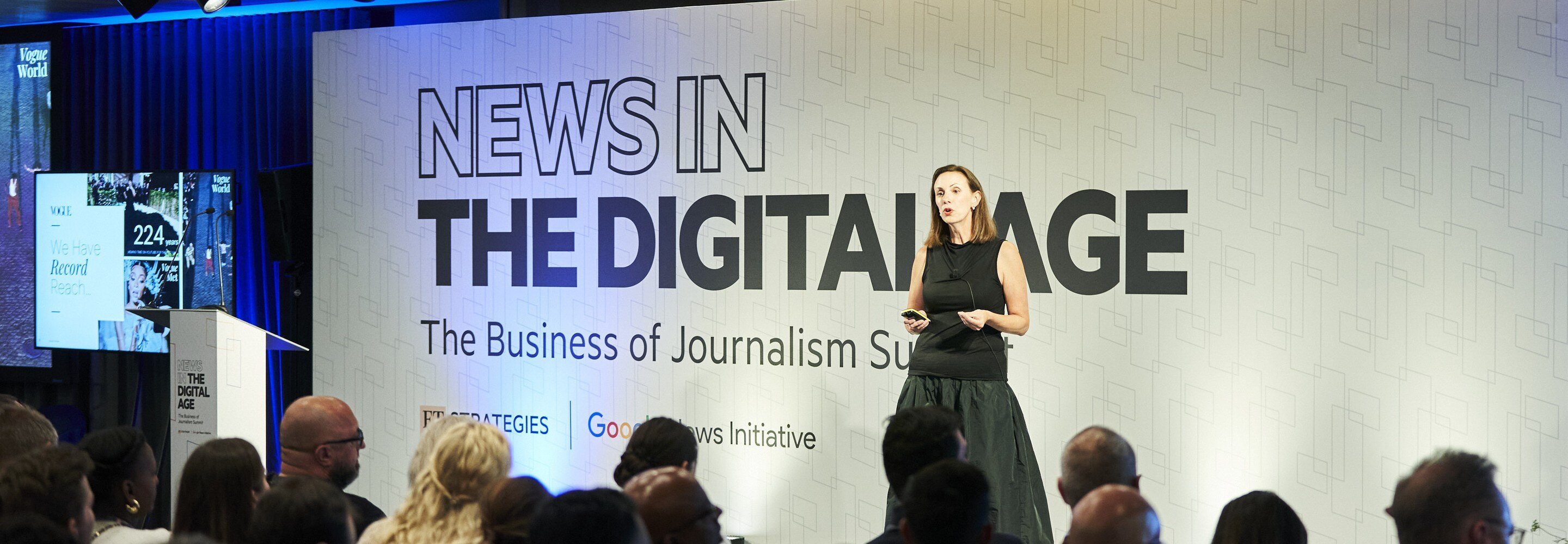
As our Next Gen News report copies flew off the stand, it was enlightening to learn just how many attendees wanted to hear more about how to engage younger audiences.
Matt Coooke, Head of Programs, AI & Misinformation at Google introduced a series of speakers, including Khalil A. Cassimally, Head of Audience Insights at The Conversation, Jodie Jackson, Founder of News Literacy Lab, Nick Petrie, Board Member of News Product Alliance and Digital Director of i newspaper and Sarah Marshall, VP, Audience Strategy at Condé Nast explained how we can create innovative news products to serve the audience of 2030. Here’s what they had to say:


News in the Digital Age 2024 hosted by FT Strategies and the Google News Initiative
News in the Digital Age 2024 hosted by FT Strategies and the Google News Initiative
Jodie Jackson, Founder of News Literacy Lab
We know young audiences are switching off from news due to the impact on their mental health. This can be due to the negativity bias in news: the tendency to report on problems or what is wrong in the world, instead of everything that is going on in the world. Solutions journalism - reporting on progress or how the wrong in the world is being addressed - is a way of correcting the bias, balancing information we make available to the public in a more truthful and reflective way. Doing this can have a positive societal effect, and we know there is appetite for this in younger audiences, can build trust and increase a reader’s likelihood of paying for news.
“Solutions journalism is no longer just a niche in news reporting, it is a necessity of modern news reporting. We are at an important moment in journalism - and I’m sure you can all agree here - what you do next matters”
Importance of connecting academia to the public via a safe environment where ideas can be challenged
Khalil A. Cassimally, Head of Audience Insights at The Conversation
Where disinformation is rife around the world, and while - in certain places - it is not safe to challenge authority, as investigative journalists do by nature, how do we present the public with factual, academically debated information?
The Conversation is a global news organisation that operates at the intersection of academia, journalism and the general public. Their 150 editors around the world commission researchers and experts in their field on topics relevant to the public, presenting accurate and evenly analysed information in an environment that is safe.
The importance of doing this is to do with connection. We know that human beings need to feel part of something bigger than themselves, like community activities or caring for others, animals and the planet.
Where trust is lacking, a consequence of disinformation or misinformation, we lose that connection.
Like The Conversation, journalists, with help from subject matter experts, can inform and empower the public to feel better connected and more informed.
“Are we able to enhance that connection, get more and more new organisations in the industry to really value and take the expertise from people who have studied these things to the general public”
Provided guidance on boosting innovation through internal alignment
Nick Petrie, Board Member of News Product Alliance and Digital Director of i newspaper
We are in a new era of the newsroom, but the prevalence of ‘church and state’ still exists. Once more familiar as ‘commercial vs editorial’, we now see internal misalignment between the people who make our ‘products’. Before the digital revolution, newspapers were the product. Editors were the product team. Now, they still exist and work alongside a digital product team - who often sit within technology teams and not within editorial. These teams believe they are responsible for the same thing: getting readers the news in the formats most relevant to them.
Despite this clash, we are all working towards the same goal and strive to remain successful through the digital era. We need internal alignment in order to achieve this, and to be truly innovative across all our product solutions as they change over time. Even if we predict those changes, the industry and market is constantly moving around us and our predictions will be wrong and outdated before long. We need to create an environment and tactics to allow us to be constantly evolving so we are prepared to react to these changes, rather than looking for a silver-bullet to solve each issue as it comes up.
We need to structure our companies in a way that allows for us to continue to develop consistently over a long period of time.
“We need to face up and say: if we really want to keep publishers that have existed around, we’re going to have to figure out how to make them look like publishers of the future - and that doesn’t look publishers of the past”
Significance of asking tough questions about audience and tech trends to ensure readiness for them
Sarah Marshall, VP, Audience Strategy at Condé Nast
Who will our audiences be in 2030? Do we look at our 15-year-olds today as future target audiences?
Audience trends
Conde Nast has never seen bigger audiences. Particularly on Youtube, Tiktok and Instagram and even connected TV. We know 18-24 year olds are on these platforms and particularly on Whatsapp. Do your strategies have tactics to reach them? Our insights tell us that they want content that is authentic and unique. They enjoy participating and interacting with content, like Wordle. They enjoy the micro-content that connects them. We know 57% of Gen Z play Roadblocks, for example. We also know they are digitally simultasking, and are sophisticated searchers.


News in the Digital Age 2024 hosted by FT Strategies and the Google News Initiative
Tech trends
It’s increasingly hard to get people on the platform. AI overviews are here to stay and we need to consider how we work with this or how it impacts us. We need to consider how privacy affects our readers' trust. We need to really think about what we can do and how we can play with the opportunities presented with the technical changes that are coming our way. What happens if Google is forced to sell Youtube? We need to think about regulation too.
How to prepare
- Forecast your audiences for 2030
- Know the size of your direct audiences
- Devise a metric that measure
- Built brand affinity off platform - position and showcase what you have that is unique
- Train your teams in sophisticated search
- Map the audience journey and remove the friction
At FT Strategies, we work with news and media organisations globally, helping them address strategic challenges, drive sustainable growth and innovate using AI, technology and data. If you would like to chat about any of these topics with our expert consultants, please get in touch.




